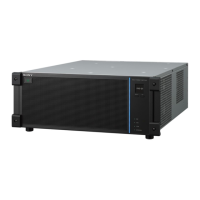83
For example, to load the image created on M/E-1 as
background B on M/E-2, press the M/E-1 re-entry button
in the cross-point button row for background B bus on
M/E-2.
• M/E-1 to M/E-3 and P/P re-entry signals are assigned to
the
cross-point buttons by default.
To use M/E-4 and M/E-5 re-entry signals, first
they
must be assigned to the cross-point buttons.
For details about assign
ing buttons, see “Creating a
Cross-Point Assign Table” (page 379).
• You can assign re-entry signal
selection buttons to the
cross-point pad of a cross-point control block/AUX bus
control block on the ICP-X7000.
For details about assign
ing buttons, see “Setting a
Cross-Point Pad” (page 405).
Re-entry signal restrictions
The following restrictions apply
when selecting a re-entry
signal.
• Up to four re-entry stages are supported.
• Selecting a re-entry signal within the same switcher
b
ank is not supported.
• When the system signal format is 720P in a 4M/E
co
nfiguration, 2-stage or greater recursive re-entry
signals cannot be selected on a key bus or utility 1 bus.
For example, if an M/E-1 signal is selected on M/E-2,
the M/E-1 a
nd M/E-2 signals cannot be selected on the
key bus and utility 1 bus of M/E-3.
Extended re-entry
When extended re-entry is enab
led, selection of re-entry
signals within the same switcher bank becomes possible.
For details, see “Setting Extended Re-Entry” (page 387).
Selecting a Bus
(Cross-Point Control
Block)
The cross-point button rows in a cross-point control block
are shared by multiple buses.
Buses are assigned to the cross-po
int button rows for use.
Operation Mode of a Button Row
The operation mode of button rows in a cross-point
control block can be selected from the following three
modes.
By default, they are set to key bus mode on the
ICP-X
7000 and to key/AUX bus delegation mode on the
ICP-X1000 series.
For details about setting th
e operation mode, see “Setting
a Button Row in a Cross-Point Control Block”
(page 403).
Key bus mode
Uses the 1st row and 2nd row as cross-point button rows
for t
he bus/utility function selected by the delegation
buttons.
Uses the 3rd row as a cross-point button row for
b
ackground A bus, and the 4th row for background B bus.
You can assign the following buses to the 1st row and 2nd
row.
Key 1 bus to key 8 bus, utility 1 bus/2 bus, DME external
v
ideo bus, DME utility 1 bus/2 bus
Free assign mode
Uses the 1st row to 4th row as cross-point button rows for
th
e bus/utility function selected by the delegation buttons.
Key/AUX bus delegation mode
Uses the 1st row as a delegation button row and the 2nd
ro
w as a cross-point button row for the bus/utility
function selected by the 1st row buttons.
Uses the 3rd row as a cross-point button row for
b
ackground A bus, and the 4th row for background B bus.
• You can also change the bus assignment using dual
backgr
ound bus mode and utility bus mode.
For details, see “Dual background bus mode”
(page 85) and “Utility bus mode” (page 85).
• You can also select a utilit
y function when a utility/
shotbox bank is assigned to a cross-point button row.
For details, see “Utility Functions” (page 233).
Notes
Notes

